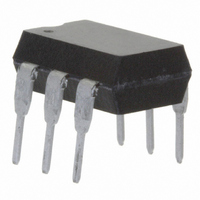IL4108 Vishay, IL4108 Datasheet - Page 6

IL4108
Manufacturer Part Number
IL4108
Description
OPTOCOUPLER PHOTOTRIAC 800V 6DIP
Manufacturer
Vishay
Specifications of IL4108
Isolation Voltage
5300 Vrms
Voltage - Isolation
5300Vrms
Number Of Channels
1
Voltage - Off State
800V
Output Type
AC, Triac, Zero Cross
Current - Gate Trigger (igt) (max)
6mA
Current - Hold (ih)
500µA
Current - Dc Forward (if)
60mA
Current - Output / Channel
300mA
Mounting Type
Through Hole
Package / Case
6-DIP (0.300", 7.62mm)
Configuration
1
Maximum Continuous Output Current
300 mA
Maximum Input Current
60 mA
Maximum Operating Temperature
+ 100 C
Maximum Power Dissipation
500 mW
Maximum Reverse Diode Voltage
6 V
Maximum Turn-on Time
35 us (Typ)
Minimum Operating Temperature
- 55 C
Typical Input Voltage
1.16 V
Zero-crossing Circuit
Yes
Zero-crossing Voltage
25 V
Output Device
PhotoTriac
Peak Output Voltage (vdrm)
800 V
Maximum Input Voltage
1.35 V
Maximum Output Voltage
560 VAC
Minimum Trigger Current
6 mA (Max)
No. Of Channels
1
Optocoupler Output Type
Phototriac
Input Current
10mA
Output Voltage
800V
Opto Case Style
DIP
No. Of Pins
6
Input Current Max
60mA
Forward Voltage
1.35V
Rohs Compliant
Yes
Number Of Elements
1
Repetitive Peak Off-state Volt
800V
Operating Temp Range
-55C to 100C
Output Current
300mA
Package Type
PDIP
Reverse Breakdown Voltage
6V
Mounting
Through Hole
Pin Count
6
Zero Crossing Circuit
Yes
Operating Temperature Classification
Industrial
Forward Current
60mA
Power Dissipation
500mW
Lead Free Status / RoHS Status
Lead free / RoHS Compliant
Lead Free Status / RoHS Status
Lead free / RoHS Compliant, Lead free / RoHS Compliant
Other names
751-1298-5
IL4108GI
IL4108GI
IL4108GI
IL4108GI
Available stocks
Company
Part Number
Manufacturer
Quantity
Price
Company:
Part Number:
IL4108
Manufacturer:
INFINEON
Quantity:
5 510
Part Number:
IL4108
Manufacturer:
INFINEON/英飞凌
Quantity:
20 000
Company:
Part Number:
IL4108-X001
Manufacturer:
INFINEON
Quantity:
5 510
Company:
Part Number:
IL4108-X001
Manufacturer:
SEIKO
Quantity:
5 510
Company:
Part Number:
IL4108-X007
Manufacturer:
ALLEGRO
Quantity:
4 600
Part Number:
IL4108-X009
Manufacturer:
VISHAY/威世
Quantity:
20 000
IL410, IL4108
Vishay Semiconductors
INDUCTIVE AND RESISTIVE LOADS
For inductive loads, there is phase shift between voltage and current, shown in the fig. 12.
The voltage across the triac will rise rapidly at the time the
current through the power handling triac falls below the
holding current and the triac ceases to conduct. The rise
rate of voltage at the current commutation is called
commutating dV/dt. There would be two potential problems
for ZC phototriac control if the commutating dV/dt is too
high. One is lost control to turn off, another is failed to keep
the triac on.
Lost control to turn off
If the commutating dV/dt is too high, more than its critical
rate (dV/dt
LED drive current I
In order to achieve control with certain inductive loads of
power factors is less than 0.8, the rate of rise in voltage
(dV/dt) must be limited by a series RC network placed in
parallel with the power handling triac. The RC network is
called snubber circuit. Note that the value of the capacitor
increases as a function of the load current as shown in fig. 13.
Failed to keep on
As a zero-crossing phototriac, the commutating dV/dt
spikes can inhibit one half of the TRIAC from keeping on If
the spike potential exceeds the inhibit voltage of the zero
cross detection circuit, even if the LED drive current I
This hold-off condition can be eliminated by using a snubber
and also by providing a higher level of LED drive current. The
higher LED drive provides a larger photocurrent which
causes the triac to turn-on before the commutating spike
has activated the zero cross detection circuit. Fig. 14 shows
the relationship of the LED current for power factors of less
than 1.0. The curve shows that if a device requires 1.5 mA
for a resistive load, then 1.8 times (2.7 mA) that amount
would be required to control an inductive load whose power
factor is less than 0.3 without the snubber to dump the
spike.
www.vishay.com
6
THE PRODUCTS DESCRIBED HEREIN AND THIS DOCUMENT ARE SUBJECT TO SPECIFIC DISCLAIMERS, SET FORTH AT
crq
21607
), the triac may resume conduction even if the
F
is off and control is lost.
Resistive load
For technical questions, contact:
Commutating dV/dt
Optocoupler, Phototriac Output, Zero Crossing,
I
F(on)
Fig. 12 - Waveforms of Resistive and Inductive Loads
This document is subject to change without notice.
High dV/dt, Low Input Current
F
I
F(off)
AC line
voltage
Voltage
across triac
AC current
through
triac
is on.
optocoupleranswers@vishay.com
Fig. 14 - Normalized LED Trigger Current vs. Power Factor
iil410_02
Fig. 13 - Shunt Capacitance vs. Load Current
iil410_01
0.001
Inductive load
0.01
0.8
2.0
1.8
1.6
1.4
1.2
1.0
0.1
1
0.0
0
C
Commutating dV/dt
s
(µF) = 0.0032 (µF)*10^0.0066 I
50
0.2
I
I
Fth
L
- Load Current (mA
100
Normalized to I
PF - Power Factor
0.4
I
150
F(on)
T A = 25 °C, PF = 0.3
I F = 2.0 mA
200
0.6
www.vishay.com/doc?91000
T
Document Number: 83627
A
250
Fth
= 25 °C
0.8
I
F(off)
AC line
voltage
Voltage
across triac
AC current
through
triac
at PF = 1.0
300
RMS
Rev. 2.0, 29-Mar-11
1.0
)
L
350
(mA)
400
1.2











